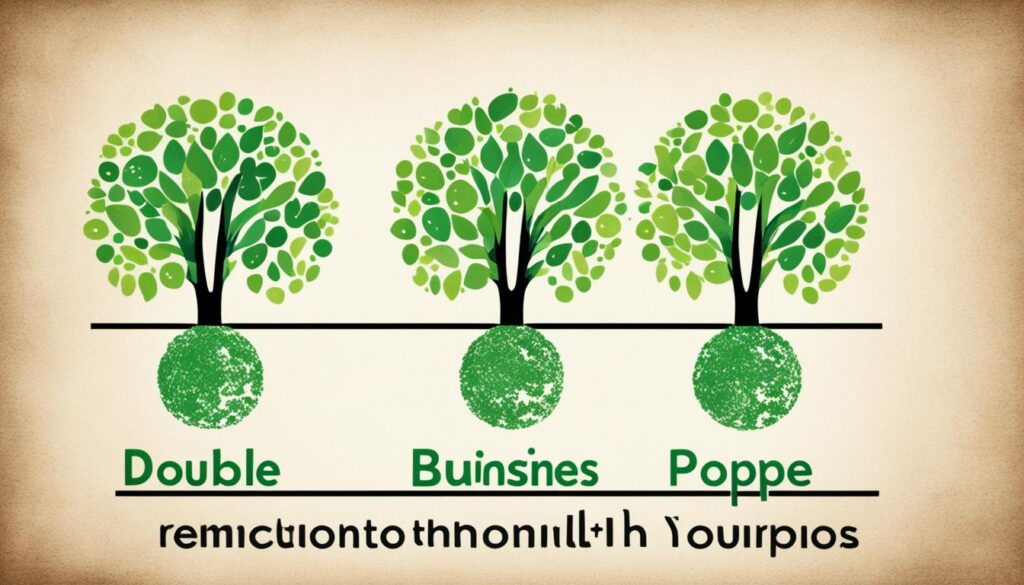What if I told you that venture capitalists don’t just chase the almighty dollar, but also seek to create positive social impact? As an experienced venture capitalist, I carefully evaluate both the financial sustainability and the potential for measurable social good when considering investments in mission-driven startups. My approach to funding social enterprises involves a delicate balance of analyzing the business model, scalability, and the venture’s ability to stay true to its core social mission.
By understanding the mindset of venture capitalists like myself, social entrepreneurs can better position their ventures to attract the right kind of investment and support. After all, impact investing and socially responsible investing are on the rise, as more investors recognize the power of blending financial returns with positive social impact.
But what exactly are the key considerations that guide venture capitalists when evaluating social enterprises? And how can social entrepreneurs ensure their ventures are attractive to mission-driven investors? Let’s dive in and explore this intriguing world of funding for social good.
Key Takeaways
- Venture capitalists evaluate both financial returns and social impact when funding social enterprises.
- Innovative business models that can scale while staying true to their social mission are particularly appealing.
- Understanding the venture capitalist mindset can help social entrepreneurs position their ventures for successful fundraising.
- The rise of impact investing and socially responsible investing has created new opportunities for mission-driven startups.
- Navigating the unique challenges of funding social enterprises requires a nuanced approach and adaptability.
Understanding the Mindset of Venture Capitalists
As a venture capitalist, I am tasked with the responsibility of allocating capital to the most promising opportunities. While traditional venture capital has historically focused on maximizing financial returns, the rise of impact investing has introduced a new paradigm where social and environmental impact carries equal weight alongside financial performance.
Balancing Financial Returns and Social Impact
At the core of my approach to funding social enterprises is the ability to strike a balance between financial returns and positive social impact. I carefully evaluate the potential for both, seeking ventures that can generate solid financial results while driving measurable positive change.
Assessing the Potential for Scalability and Growth
In addition to the dual focus on profits and purpose, I also pay close attention to the scalability and growth potential of social enterprises. I look for business models that can be replicated and expanded while maintaining their social mission, ultimately creating a sustainable and impactful venture.

How do venture capitalists approach funding for social enterprises?
When considering funding for social enterprises, I employ a rigorous due diligence process that goes beyond the traditional financial metrics. I start by thoroughly understanding the venture’s social mission and how it is interwoven into the business model alignment.
Due Diligence Process for Social Enterprises
The due diligence process for social enterprises involves a comprehensive evaluation of the venture’s potential for sustainable impact and financial viability. I closely examine the organization’s track record, management team, and operational efficiency to assess its ability to deliver on its stated social objectives while maintaining a healthy bottom line.
Evaluating the Social Mission and Business Model Alignment
A critical component of my funding approach is ensuring that the social enterprise’s mission and business model are tightly aligned. I look for ventures that have a clear, measurable, and scalable social impact proposition that is seamlessly integrated into their core operations and value proposition. This alignment is essential for creating lasting positive change while also delivering attractive financial returns.

The Rise of Impact Investing
The landscape of venture capital and investment has been evolving, with the growing prominence of impact investing. This approach seeks to generate positive social and environmental impact alongside financial returns, reflecting a shift in investor priorities. The rise of impact investing has given birth to a new era of socially responsible investing strategies, as investors increasingly seek to align their capital with their values and desired social outcomes.
Socially Responsible Investing Strategies
Venture capitalists and investors are now exploring a range of socially responsible investing strategies that prioritize both financial performance and social impact. These strategies may include investing in mission-driven startups, supporting social enterprises, or allocating capital to funds and portfolios with a focus on environmental, social, and governance (ESG) factors. By adopting these socially responsible investing approaches, investors can play a pivotal role in driving positive change while still seeking attractive financial returns.
Measuring and Reporting Social Impact
As the rise of impact investing continues, there is a growing emphasis on measuring and reporting social impact. Venture capitalists and investors are increasingly seeking to understand and quantify the tangible social and environmental outcomes of their investments. This involves developing robust impact measurement frameworks, collaborating with social enterprises to track and report on key performance indicators, and communicating the social impact of their investment portfolio to stakeholders.

Social Entrepreneurship and Mission-Driven Startups
The rise of social entrepreneurship has given birth to a new generation of mission-driven startups that are redefining the traditional business landscape. These enterprises are driven by a dual mandate of profitability and positive social impact, challenging the notion that profit and purpose are mutually exclusive. As a venture capitalist, I am increasingly drawn to the potential of these social entrepreneurship initiatives, which are reshaping the way we approach business and investment.
Attracting Venture Capital for Social Enterprises
One of the key challenges for mission-driven startups is attracting the right kind of venture capital to support their growth and scale. Traditional venture capitalists have typically focused on maximizing financial returns, but the emergence of impact investing has opened new avenues for funding social enterprises. By aligning investment strategies with measurable social and environmental impact, forward-thinking venture capitalists like myself are able to support the development of innovative mission-driven startups that are poised to drive meaningful change.
To effectively attract venture capital, social entrepreneurs must be able to articulate a compelling value proposition that demonstrates the potential for both financial sustainability and positive social impact. This requires a deep understanding of the venture capitalist’s mindset and a willingness to engage in a nuanced dialogue that transcends the traditional focus on pure profitability.
| Key Strategies for Attracting Venture Capital | Metrics of Success |
|---|---|
|
|
By embracing the principles of social entrepreneurship and aligning their ventures with the priorities of mission-driven investors, entrepreneurs can unlock the transformative potential of venture capital to drive positive change at scale.

Blended Finance Models for Social Enterprises
To support the growth and development of social enterprises, innovative financing models known as blended finance have emerged. These models combine philanthropic capital, such as grants and donations, with commercial investment to create a hybrid funding structure that can better meet the needs of mission-driven startups.
Combining Philanthropic and Commercial Capital
By leveraging a blend of philanthropic and commercial capital, social enterprises can access a wider range of funding sources to finance their operations and scale their impact. Philanthropic capital, often in the form of grants or concessional loans, can provide the necessary seed funding or risk-taking capital to kickstart these ventures, while commercial investment can offer growth-stage financing and access to broader financial markets.
Leveraging Hybrid Financing Structures
Blended finance models often employ hybrid financing structures that blend different types of capital, each with its own risk-return profile and investment objectives. This approach allows social enterprises to tap into a diverse pool of investors, from impact-driven philanthropists to traditional venture capitalists seeking a combination of financial returns and positive social impact.
These innovative financing structures can take various forms, such as convertible grants, pay-for-success models, or layered capital structures that prioritize different investor needs and risk appetites. By combining philanthropic and commercial capital, social enterprises can better navigate the challenges of funding their ventures and achieve the delicate balance between profitability and social impact.

The Double Bottom Line: Profits and Purpose
At the heart of my approach to funding social enterprises is the recognition of the “double bottom line” – the need to balance financial returns with measurable social and environmental impact. This concept of the double bottom line, and in some cases the “triple bottom line” (which also considers environmental impact), has become a guiding principle for mission-driven startups and the venture capitalists who support them.
As an increasing number of social entrepreneurs and investors realize that social enterprises can generate returns acceptable to financial markets, the landscape of funding for these ventures has evolved. Social enterprises can now tap into traditional sources of funding, such as venture capital firms, banks, mutual funds, and bonds, if charitable donations are treated as capital seeking social returns.
However, the social enterprise sector needs greater precision and transparency in measuring and reporting social outcomes to attract a larger universe of investors. Forward-thinking social investors like the Bill & Melinda Gates Foundation, Bridges Ventures, and BlueOrchard are leading the way in leveraging funding for maximum social benefit.
The financial crisis of 2008 damaged the credibility of financial innovation, leading to a reevaluation of financial instruments like collateralized debt obligations and credit default swaps. Efforts are now underway to build market infrastructure and legal frameworks to harness innovative financial approaches for social enterprises, ensuring that the double bottom line of profits and purpose can be achieved.

Venture Philanthropy and Social Impact Investing
As the landscape of social entrepreneurship and impact investing has evolved, I have witnessed the rise of venture philanthropy and social impact investing approaches. These strategies blend the principles of traditional venture capital with a philanthropic mindset, allowing for more strategic and engaged investments in social enterprises.
Strategic Philanthropic Investments
Venture philanthropy involves making strategic philanthropic investments in mission-driven organizations, focusing on building their capacity and long-term sustainability. Unlike traditional grant-making, this approach emphasizes active engagement, hands-on support, and a focus on measurable social impact rather than just financial returns.
Building Capacity for Social Enterprises
Through social impact investing, I have had the opportunity to support the growth and development of social enterprises by providing not only financial capital but also strategic guidance, mentorship, and access to professional networks. By building the capacity of these organizations, I aim to help them scale their positive impact and become self-sustaining over time.
The combination of venture philanthropy and social impact investing has enabled me to take a more holistic approach to funding social enterprises. By blending philanthropic and commercial capital, I can create innovative financing structures that cater to the unique needs of mission-driven startups, empowering them to achieve their social and financial objectives.

Challenges in Funding Social Enterprises
While the rise of impact investing and social entrepreneurship has presented exciting opportunities, there are also significant challenges in funding social enterprises. Navigating these challenges requires a nuanced approach and a willingness to adapt to the unique circumstances of each venture.
Aligning Expectations and Measuring Success
One of the key challenges in funding social enterprises is aligning expectations and measuring success. Traditional venture capitalists often focus on maximizing financial returns, while social entrepreneurs may prioritize measurable social impact. Finding the right balance between these two can be a delicate and complex process, requiring open communication, transparency, and a shared understanding of success metrics.
Navigating Regulatory and Legal Frameworks
Another significant challenge in the funding of social enterprises is navigating the regulatory and legal frameworks that govern the social impact sector. These enterprises operate in a space that often intersects with complex regulations, tax policies, and legal considerations, which can be daunting for both the entrepreneurs and the investors. Staying up-to-date with the evolving landscape and being proactive in addressing these issues is crucial for securing the necessary funding and support.
| Challenges in Funding Social Enterprises | Strategies for Overcoming Them |
|---|---|
| Aligning Expectations and Measuring Success | Establish clear, measurable metrics for both financial and social impact; Engage in transparent communication and iterative goal-setting with investors |
| Navigating Regulatory and Legal Frameworks | Seek legal and regulatory expertise; Stay informed on evolving policies; Collaborate with policymakers and industry associations to address systemic issues |
By addressing these challenges head-on, social enterprises can position themselves to attract the right kind of funding and support, ultimately driving positive change and creating a more sustainable future.

Success Stories: Venture-Backed Social Enterprises
Throughout my experience as a venture capitalist, I have had the privilege of supporting and witnessing the success of several social enterprises that have demonstrated the power of blending financial acumen with a strong social mission. These venture-backed social enterprises have not only achieved impressive financial results but have also made a tangible and measurable impact on the communities they serve.
Highlighting Innovative Business Models
One such success story is Acme Sustainable Solutions, a startup that has revolutionized the recycling industry through its innovative business model. By leveraging technology and strategic partnerships, Acme has been able to dramatically improve the efficiency and profitability of recycling operations, all while prioritizing environmental stewardship and social responsibility.
Another inspiring example is Bloom Impact Investing, a financial services firm that has pioneered a unique approach to impact investing. By combining traditional investment strategies with a deep understanding of social entrepreneurship, Bloom has been able to deliver competitive financial returns while also creating measurable positive impact for underserved communities.
Inspiring Future Social Entrepreneurs
The success stories of these venture-backed social enterprises serve as a powerful inspiration for aspiring social entrepreneurs who are eager to launch their own mission-driven startups. By demonstrating the viability of blended finance models and the potential for socially responsible investing to generate both financial and social returns, these enterprises are paving the way for a new generation of innovative business models that prioritize purpose alongside profit.
As a venture capitalist, I am immensely proud to be a part of this movement towards a more sustainable and equitable future. By supporting these success stories of venture-backed social enterprises, I believe we can inspire and empower future social entrepreneurs to pursue their own bold visions for positive change.

Conclusion
As a venture capitalist, I have a unique perspective on the funding and growth of social enterprises. I have seen firsthand the power of mission-driven startups to create positive social and environmental change while also generating financial returns. The rise of impact investing and the double bottom line approach have transformed the investment landscape, allowing me to support enterprises that are not only profitable but also deeply committed to making a meaningful difference in the world.
The journey of funding social enterprises has been both challenging and rewarding. Navigating the nuances of aligning expectations, measuring success, and adapting to regulatory frameworks requires a deep understanding of the social entrepreneurship ecosystem. However, the success stories of innovative business models and the inspiration they provide to future social entrepreneurs make the effort worthwhile.
Moving forward, I am confident that the trend towards conclusion impact investing and mission-driven startups will continue to grow. As a venture capitalist, I remain committed to identifying and supporting the most promising social enterprises that can create sustainable and scalable solutions to pressing social and environmental issues. By fostering a collaborative ecosystem and empowering these enterprises, I believe we can collectively work towards a future where profit and purpose are seamlessly interwoven, benefiting both investors and the communities we serve.
